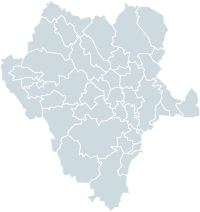Durango
| State of Durango | |||
|
|||
 |
|||
 |
|||
| Country | |||
|---|---|---|---|
| Capital | Durango | ||
| Municipalities | 39 | ||
| Government | |||
| - Governor | Ismael Hernández Deras (PRI) | ||
| - Federal Deputies | PRI: 3 PAN: 1 |
||
| - Federal Senators | PAN: 2 PRI: 1 |
||
| Area Ranked 4th |
|||
| - Total | 123,181 km² (47,560.4 sq mi) | ||
| Population (2005) | |||
| - Total | 1,509,117(Ranked 23th) | ||
| Time zone | CST (UTC-6) | ||
| - Summer (DST) | CDT (UTC-5) | ||
| HDI (2004) | 0.7910 - medium Ranked 15th |
||
| ISO 3166-2 | MX-DUR | ||
| Postal abbr. | Dgo. | ||
| Website: Durango State Government | |||
Durango (pronounced [duˈɾaŋgo]) is one of the constituent states of Mexico. Its population is 1,509,118.[1] It has Mexico's second-lowest population density, after Baja California Sur. The city of Durango is the state's capital.
Contents |
Geography
The "estado" of Durango is bordered to the north by Chihuahua, to the north-east by Coahuila, to the south-east by Zacatecas, to the south-west by Nayarit, and to the west by Sinaloa. Most of the state is heavily mountainous and a good part forested, the Sierra Madre Occidental occupies the western and central part of the state. This mountain range contains a good supply of minerals, including the silver that encouraged Spanish occupation of the territory after it was discovered. These mines extend north into Chihuahua and south into the state of Zacatecas. Vast desert basins in the Laguna District are irrigated by the Nazas River.
Major crops grown in the area include cotton, wheat, corn, alfalfa, marijuana, beans, sorghum, and other vegetables.
Durango is famous for its scorpions. Mexicans generally refer to the people of Durango as Alacrán de Durango (A scorpion from Durango). The demonym for the natives of Durango is Duranguenses.
The major occupations in Durango are farming, lumbering and ranching.
History
Francisco de Ibarra, the first to colonize Durango, settled this part of the vast northern province of Nueva Vizcaya in 1563, when he founded the capital city and named it Durango for the basque town Durango, Biscay, Spain, Europe. The foundation was just one in his larger program of initiating settlements throughout the province.
This was a late colonization for the Spanish, due mostly to heavy resistance by the indigenous population. From first contact to modern times, the indigenous peoples have attempted to gain some autonomy, address grievances, and maintain traditional land ownership.
Spanish colonists became highly attracted to the Durango area for its mining and grazing prospects.
In 1823, shortly after victory over Spain in the Mexican War of Independence, Durango earned the right to become a separate state.
Municipalities
Durango is divided into 39 municipalities (municipios). See municipalities of Durango.
Major communities
- Durango (Victoria de Durango)
- El Salto
- Gómez Palacio
- Lerdo (Ciudad Lerdo)
- Santiago Papasquiaro
- Tepehuanes
- Santa María del Oro
- Guanaceví
- Topia
- Peñón Blanco
Popular culture
- Bob Dylan co-wrote a song called "Romance in Durango" with Jacques Levy for his 1976 album Desire (album).
- In Stanley Kubrick's A Clockwork Orange, the sports car driven by Alexander deLarge and his droogies is called a "Durango 95".[2][3]
- Punk rock band The Ramones often opened their live act with a song called "Durango 95".
- Actor John Candy suffered a fatal heart attack in Durango, while filming his final motion picture Wagons East.
- In the book The House of the Scorpion, Mateo Alacran (referred to as "El Patrón"), a drug lord, was born in Durango, as was Celia. The last name he adapted, "Alacran", is a reference to the term Alacran de Durango.
- The film Dragonball by James Wong is to be filmed in this state.
The 1948 film The Treasure of the Sierra Madre, starring Humphrey Bogart, Walter Huston, and Tim Holt, was set in the state of Durango.
- In the 1970 film Moonfire, the main storyline is set here.
- In the song Spanglish by The Game (rapper) he refers to the state in the end of his first verse by saying "Get it from Durango, take it to Chicago"
Notable people
- Francisco "Pancho" Villa
- Dolores Del Rio
- Guadalupe Victoria
References
- ↑ As of the 2005 census
- ↑ http://www.imps4ever.info/specials/centaur/durango.html
- ↑ http://www.geocities.com/hasselhoffline/images/mm/aco/propdurango.jpg
External links
- (Spanish) Durango State Government
- (Spanish) Durango 1000's of Pictures of Local Rural Communities
- John P. Schmal, "The history of indigenous Durango" detailing the series of revolts
- Territorial Division (legal text, Spanish)
|
||||||||||

